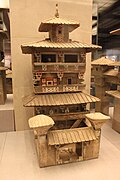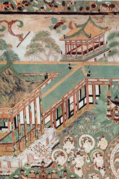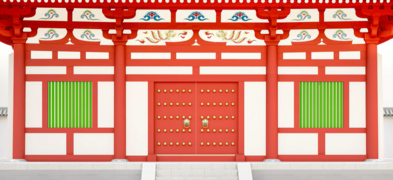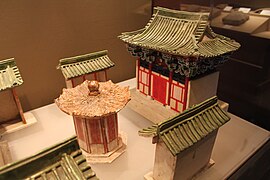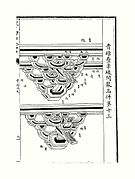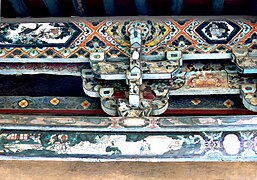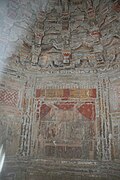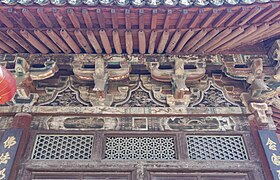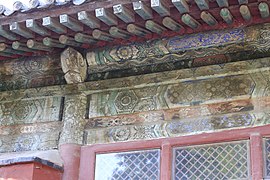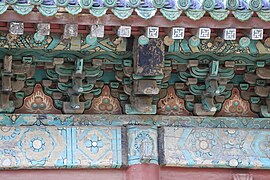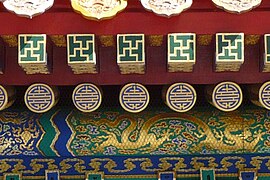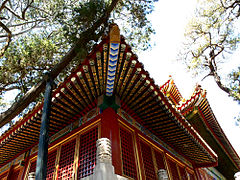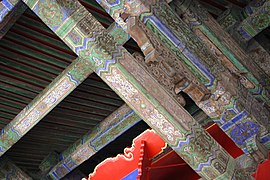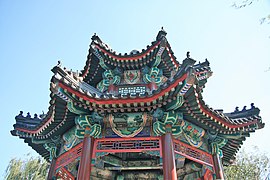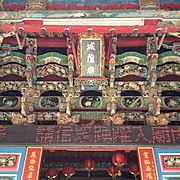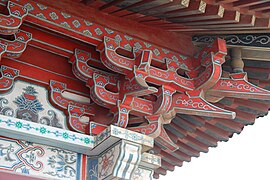Caihua
You can help expand this article with text translated from the corresponding article in Chinese. (January 2022) Click [show] for important translation instructions.
|
| Caihua | |||||||||
|---|---|---|---|---|---|---|---|---|---|
 Caihua of the Forbidden City | |||||||||
| Traditional Chinese | |||||||||
| Simplified Chinese | |||||||||
| Literal meaning | "Colour-painting" | ||||||||
| |||||||||
Caihua (Chinese:
History
[edit]This section needs expansion. You can help by adding to it. (January 2022) |
The origins of Caihua can be traced back to the Zhou dynasty,[3][4] as the Zuo Zhuan and Guliang Zhuan detailed:
“
秋 ,丹 桓宮楹。禮 ,天子 、諸侯 黝堊,大夫 倉 ,士 黈,丹 楹,非禮 也。[5] (the duke painted red the pillars of [duke] Huan's temple. According to rule, King and royalty use dark and white, gentry use white, yeoman use yellow. Red pillars are against etiquette.)
The Rites of Zhou similarly records a ritualistic usage of motifs and colour, based on each respective aspects' corresponding symbolic value.
Gallery
[edit]-
Painted elements can be seen on Han dynasty pottery tower.
-
Painted elements can be seen on Han dynasty pottery tower.
-
Example of Tang dynasty decorative motifs, from mural of Mogao Caves.
-
Example of Tang dynasty decorative motifs on architecture, from mural of Mogao Caves.
-
Recreation of Tang dynasty caihua architectural decorations.
-
Recreation of Tang dynasty caihua architectural decorations.
-
Tang dynasty sancai model of a building.
-
Song Dynasty "Wucai Caihua" (Five Coloured Painting)-dougong decorations guide as detailed on the Yingzao Fashi
-
Song Dynasty "Danfen Caihua" (Red and White)-dougong decorations guide as detailed on the Yingzao Fashi.
-
Song Dynasty "Qinglü" (Blue and Green)-decorations guide as detailed on the Yingzao Fashi.
-
Song Dynasty "Jielü Caihua" (Open Green)-decorations guide as detailed on the Yingzao Fashi.
-
Song Dynasty ruyi-decorations on beams guide from the Yingzao Fashi.
-
Song Dynasty ruyi-decorations on beams guide from the Yingzao Fashi.
-
Song Dynasty pillar decorations guide from the Yingzao Fashi.
-
Song Dynasty decorations used in between dougong-brackets guide from the Yingzao Fashi.
-
Buddhist decorations of Ten-Thousand Buddha Hall of Zhenguo Temple, Five Dynasties period.
-
Decorations on Liao dynasty Geyuan Temple.
-
Caihua found on Jinci temple, Song Dynasty.
-
Frescos of Song Silang's Tomb, Northern Song Dynasty.
-
Frescos of Song Silang's Tomb, Northern Song Dynasty.
-
Weathered decorations on Yuanmiao Temple (Putian) dougong. Originally Song dynasty construction.
-
Jin dynasty Jingtu Temple of Shanxi.
-
Datong Confucian temple inner hall decorations.
-
Ming dynasty decorations on Hall of Amitābha at Longxing Temple.
-
Ming dynasty decorations on Jialan Hall at Foguang Temple.
-
Ming dynasty decorations on Hall of Amitābha at Longxing Temple.
-
Ming dynasty decorations on Hall of Amitābha at Longxing Temple.
-
Xuanzi-style decorative design on the Beijing Dongyue Temple
-
Caihua found on the Gate of Heavenly Purity of the Forbidden City
-
Hexi-style decorative design on the Imperial Palace gate of the Forbidden City
-
Underside decorations of Qin'an Hall of the Forbidden City
-
Decorations on support beams inside a palace of the Forbidden City.
-
Datong Guandi temple.
-
Decorations on Summer Palace pavilion
-
Magong Chenghuang Temple decorations, Taiwan.
-
Painted mural depicting an event from Journey to the West on the Long Corridor from Qing Dynasty Summer Palace
-
Caihua-decorations of Pavilion of Prince Teng, inspired by Song dynasty Yingzao Fashi decorations.
-
Caihua-decorations of Pavilion of Prince Teng, inspired by Song dynasty Yingzao Fashi decorations.
-
Caihua-decorations of Pavilion of Prince Teng, inspired by Song dynasty Yingzao Fashi decorations.
See also
[edit]- Hexi Caihua
- Ancient Chinese wooden architecture
- Chinese architecture
- Yingzao Fashi
- Architecture of the Song Dynasty
- Dancheong
References
[edit]- ^ 孙大
章 (1991).中国 古代 建 筑彩画 [Ancient Chinese Architectural Colored Drawings] (in Chinese).建 筑工业出版 社 . ISBN 7-112-07328-6. - ^ 赵双
成 (2006).中国 建 筑彩画 图案 [Chinese architecture painting design] (in Chinese).天津 大学 出版 社 . ISBN 978-7561822494. - ^ 刘敦桢 (Liu Dunzhen) (1991).
中国 古代 建 筑史 [History of Chinese Ancient Architecture] (2 ed.).中国 建 筑工业出版 社 ;第 2版 (China Architecture Building Press). ISBN 9787112019298. - ^ Flags, color, and the legal narrative : public memory, identity, and critique. Anne Wagner, Sarah Marusek. Cham, Switzerland: Springer. 2021. p. 129. ISBN 978-3-030-32865-8. OCLC 1253353500.
{{cite book}}: CS1 maint: others (link) - ^
穀 梁 子 . . Vol.莊 公 ,二 十 三 年 – via Wikisource.


